The secret to unlocking Britain’s clean energy future might be found in giant floating wind farms.
These enormous floating structures can reach up to 240 metres (787ft) in height – around the same size as a skyscraper.
And experts predict they could make up 10 per cent of the UK’s wind farms by 2030.
However, building an enormous tower designed to sit in high winds poses some significant engineering issues.
From ‘spars’ that bob like fishing lures to cutting-edge hybrid platforms, engineers have created hundreds of different designs for these clean-energy giants.
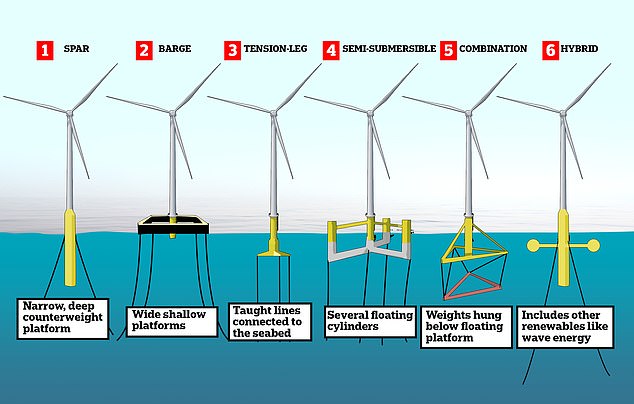
There are six different types of floating wind turbines which have been developed. They range from simple designs like the spar to more complex hybrid platforms
Currently, most wind turbines that you see are ‘fixed’ turbines, meaning they have been drilled into the sea floor.
This method is very effective at ensuring the turbine can resist the strong winds it is meant to harness, but isn’t always the best option.
Dr Emma Edwards, an engineer at University of Oxford who develops floating platforms, told MailOnline that fixed turbines can’t be used in the windiest areas.
She explained: ‘The wind is much stronger and more reliable in deep water. 80 per cent of global wind capacity is located in water depths that are too deep for fixed platforms.’
Since it would be too expensive, or simply impossible, to drill into the seabed, the better solution is for turbines to float above it.
The challenge for engineers is to design a floating platform that can keep a 240m-tall tower from swaying too much in extremely strong winds.
While Dr Edwards says there are hundreds of different unique designs, these broadly fit into six different categories.
1. Spar
The simplest, and potentially cheapest way to build floating farms is by building ‘spar’ turbines.
These counteract the force of the wind by extending a weight to the bottom that extends deep underwater.
Just like a fishing lure, these towers bob above the surface while the counterweight keeps them upright even in strong winds.
The counterweight, or ballast, can be more than 100 metres below the surface, making the overall structures enormous.
Some spar turbines are 253 metres tall, with 78 metres submerged under the sea and anchored to the sea bed by cables.
This presents an issue since most normal docks aren’t deep enough to accommodate something of this size.
Dr Edwards explains that the turbines need specialist installation procedures to install the platform once it has been towed to deep water.
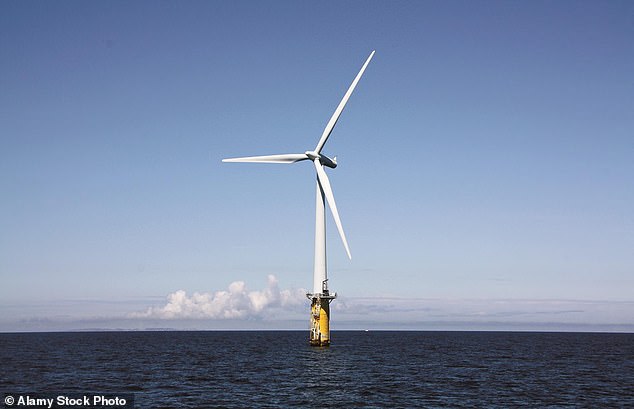
Spar turbines like this one off the coast of Scotland have a single, long counterweight which extends up to 100 metres of more beneath the water
2. Barge
Rather than going deep like a spar, barge systems spread themselves out wide.
Barges use large, shallow platforms to spread the weight of the turbine over a larger area.
Since the platform extends less than 10 metres below the surface of the water, they can be towed straight out to sea from a standard dock.
This could potentially make barges cheaper since they don’t need any specialist installation vessels or equipment.
However, as Dr Edwards writes in The Conversation: ‘They can be difficult to make because the platform is usually a single, large unit with a complex shape.’
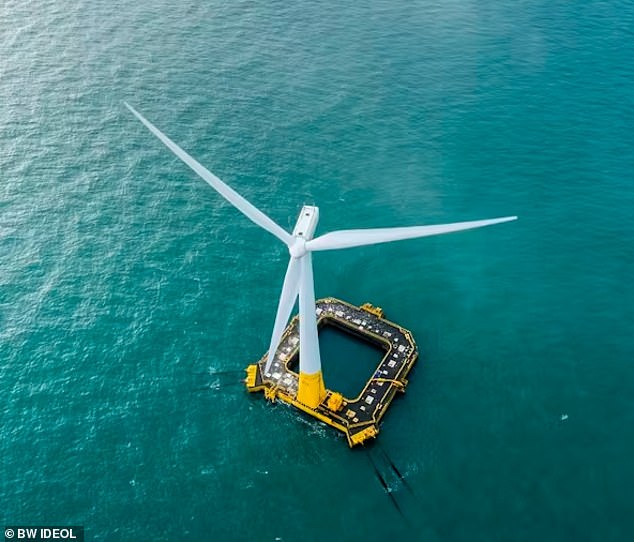
Barge turbines like this use a very large, shallow platform to spread out the weight of the turbine and prevent it swaying in the wind
3. Tension-leg platform
Tension-leg platforms (TLPs), as the name suggests, make use of tension instead of buoyancy to overcome the force of the wind.
The turbines use a smaller platform which is secured to the sea bed using mooring lines which hold the system upright.
Since there is no deep drilling required to install these lines, TLPs can be used in much deeper seas than fixed alternatives.
Also, since they tend to be smaller and lighter than barges or spars they are easier to construct at standard ports and don’t have much of an impact on the sea bed.
However, the platforms are not stable by themselves until the lines have been secured.
This means they do need specialist towing equipment to safely take them out to sea where they can be secured.
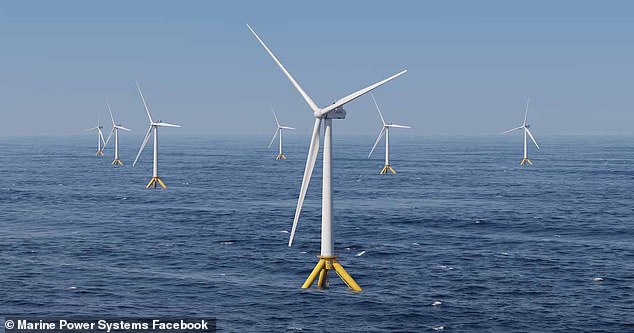
Rather than drilling into the sea bed, tension leg platforms, as shown in this artist’s impression, use long cables to connect to anchor to the sea floor
4. Semi-submersible
These platforms combine elements from both barges and spars to try and solve some of the problems of both.
They consist of between three and five vertical cylinders, with the turbine in the middle.
This spreads out the weight of the turbine while also acting as a counterbalance in high winds.
Dr Edwards says: ‘Like barges, semi-submersibles do not require specialist tow-out equipment and work for a wide range of water depths.’
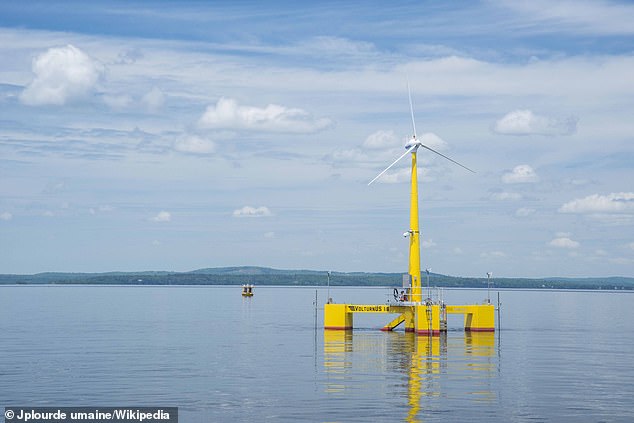
Semi-submersible turbines, like this one developed by the University of Maine, use several pillars which sink below the surface to act as a counterweight for the platform
5. Combination-type
Combination types are a broader category of platforms that mix together elements from all the other styles.
Dr Edwards told MailOnline that these often take inspiration from the oil rigs.
‘Large floating platforms have been used in the oil and gas industry for 60 years,’ she says.
These rigs can access deeper water sites by using a combination of semi-submersible or TLP designs.
However, there is now a push to develop wind-power specific floating platforms that use these same advantages.
One promising design uses a lowerable ballast to stay stable.
These look like traditional barge platforms but can lower a large weight from taught cables once they have been taken out to see.
This combines the easy installation of barges with the added stability of having a deep counterweight.
6. Hybrid platforms
The last category of platforms are those that try to get more bang for their buck by combining multiple renewable-energy systems in one package.
These designs often include wave energy converters or solar panels to gather even more energy while out at sea.
And, since the power is all from one source, this drastically reduces the amount of cables you need to build to connect everything up.
As a bonus, using a wave energy converter even helps dampen the motion of the platform.
This results in a steadier wind turbine which increases the power production even further.
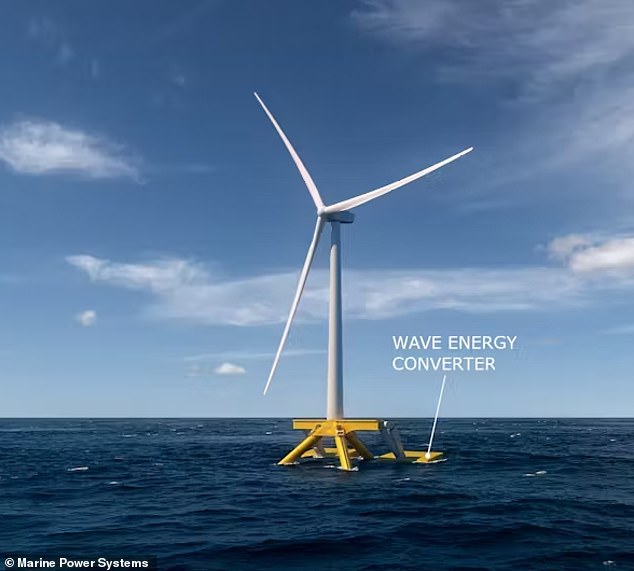
Hybrid power systems, as shown in this artist’s impression, combine two or more different types of renewable, most frequently wave converters, to generate even more power
Where have floating wind farms already been built?
Since floating wind farms can tap into the reserves of power in deep water, they are receiving a lot of attention from governments and researchers.
There are currently four fully operational floating wind farms in Europe alongside a number of test sites and pilot projects around the world.
The largest is the Hywind Tampen wind farm which was opened in 2023 off the coast of Norway.
This farm is made up of 11 floating turbines and provides 88MW of power.
However, this power is currently used to support offshore oil and gas projects rather than being transported back to Norway for public use.
In China, the Shanghai Electric Wind Power Group recently unveiled the first hybrid wind farm which includes solar panels and an area for fish farming.
According to the company, it should produce 96,000 kWh of electricity daily at full capacity, enough to provide power for around 42,500 people.
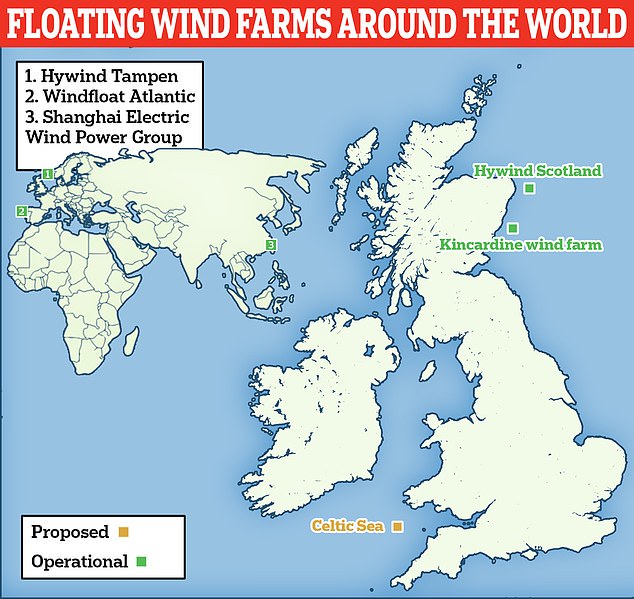
There are currently four operational floating wind farms in Europe and one hybrid power plant beginning operations in China. Two of Europe’s are located in Scotland
Are there any floating wind farms in Britain?
Two of Europe’s four floating wind farms are located off the coast of Scotland.
Hywind Scotland and the Kincardine wind farm are both home to small-scale pilot projects of a few turbines each.
Hywind Scotland has five spar turbines which collectively produce enough energy for 35,000 UK homes.
The Kincardine wind farm meanwhile has another five floating turbines which use barges.
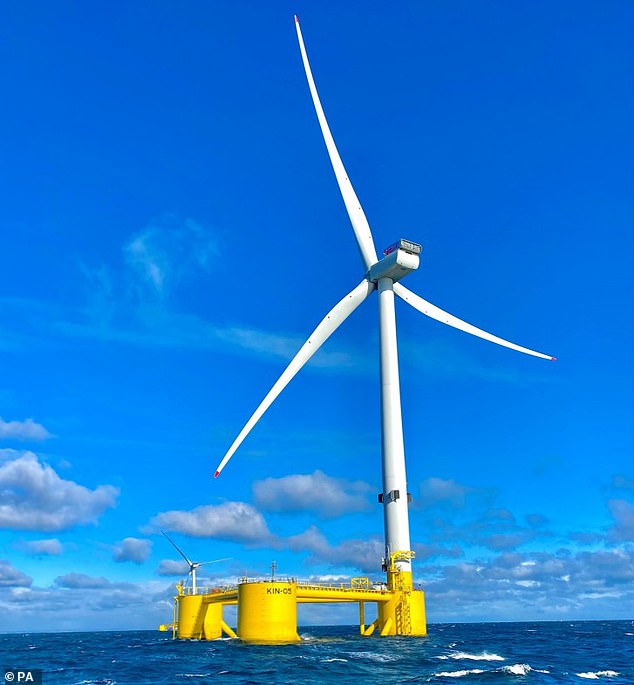
This floating wind turbine is part of the Kincardine wind farm in Scotland. The Kincardine wind farm has five turbines which can collectively power 35,000 homes
While these might seem like a small start, at least 10 per cent of the UK’s wind turbines should be floating by 2030, according to Dr Edwards.
Last year, the government finalised plans for three areas of floating wind farms in the Celtic Sea, not far from the Bristol Channel.
Each of these three sites will produce up to 100MW, although the government claims that the entire Celtic Sea project could eventually provide 4GW of power.
Dr Edwards told MailOnline: ‘In the UK, the water depth is “intermediate,” and therefore barges, TLPs or semi-submersibles look best-placed for deployment.’













